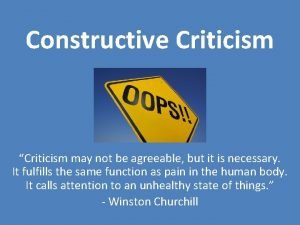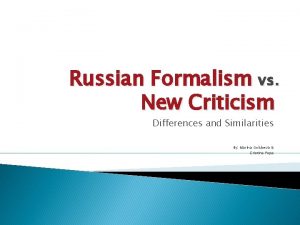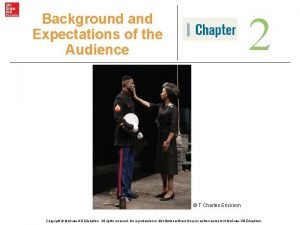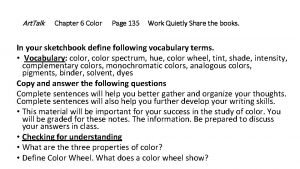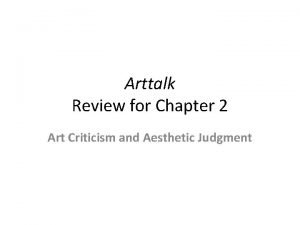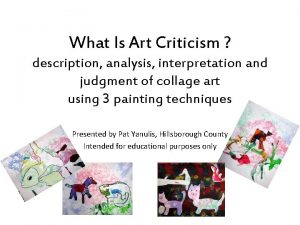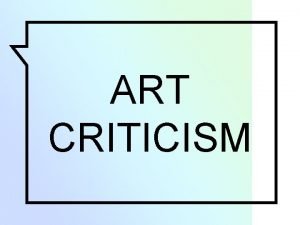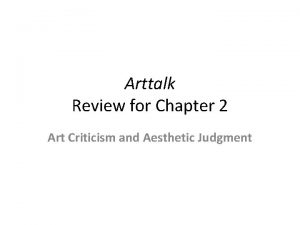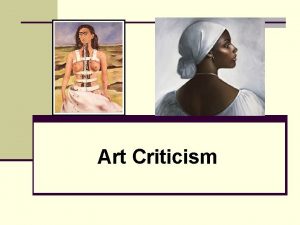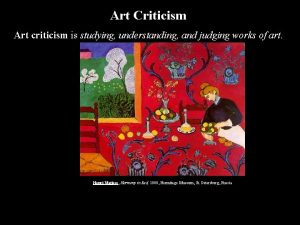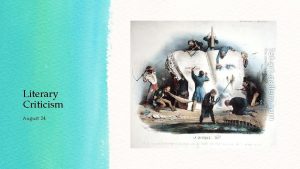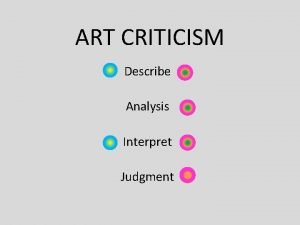Arttalk Review for Chapter 2 Art Criticism and










- Slides: 10

Arttalk Review for Chapter 2 Art Criticism and Aesthetic Judgment

Lesson 1: Art Criticism: Learning from a Work of Art • Art critics use different criteria, or standards of judgment, to assess works of art. • The process of interpretation will improve your aesthetic experience, or your personal interaction with a work of art. • Aesthetics is the philosophy or study of the nature and value of art.

Art criticism is an organized approach for studying a work of art. It is made up of four steps that must be taken in order.

(1) Description: • Ask yourself, what do I see? Make a list of all the things you see in the work, including the work’s subject and the elements of art that are used. Include information from the credit line about the size of the work and its medium • This is the most objective step in critiquing a work of art. • Art Historians look for information about the art, not in the art.

(2) Analysis: • Ask, how is the work organized? Look at how the principles of art are used to organize the art elements of line, space, color, form, and texture • Art Historians consider the artist’s individual style.

(3) Interpretation: Ask, what is the artist trying to communicate? Try to explain the meaning or mood of the work, based on your clues from the first two steps. You can make guesses about the artwork as long as they are supported by what you see in the work. Requires Research

(4) Judgment: • Now ask, is this a successful work of art? You determine the degree of artistic merit. You can decide whether you like or dislike the work and whether the work is successful aesthetically. • So when you are considering how well an object works you would being using your judgment. • Also requires research • You use personal and aesthetic levels of Judgments.

Key Terms • When looking at literal qualities, they judge the realistic qualities that appear in the subject of the work. • When looking at formal qualities, they study how well a work is organized. • To judge expressive qualities, critics consider those qualities that convey ideas and moods.

Key Terms • The theories that rate these different qualities most highly are called Imitationalism, Formalism, and Emotionalism. • Imitationalism focuses on realistic representation; • Formalism places emphasis on the design qualities; and • Emotionalism requires that a work arouse a response of feelings, moods, or emotions in the viewer.

When criticizing functional objects, when should you consider how well the object works? • • during the judgment step during the interpretive step during the descriptive step during the analysis step
 Appreciation and criticism
Appreciation and criticism Learn something
Learn something Russian formalism new criticism difference between
Russian formalism new criticism difference between Source criticism definition
Source criticism definition Descriptive criticism vs prescriptive criticism
Descriptive criticism vs prescriptive criticism Chapter review motion part a vocabulary review answer key
Chapter review motion part a vocabulary review answer key Art talk chapter 6 review answers
Art talk chapter 6 review answers Art talk chapter 2 review answers
Art talk chapter 2 review answers The art of public speaking chapter 1 review questions
The art of public speaking chapter 1 review questions Interpret and analyze
Interpret and analyze Steps of art criticism
Steps of art criticism

